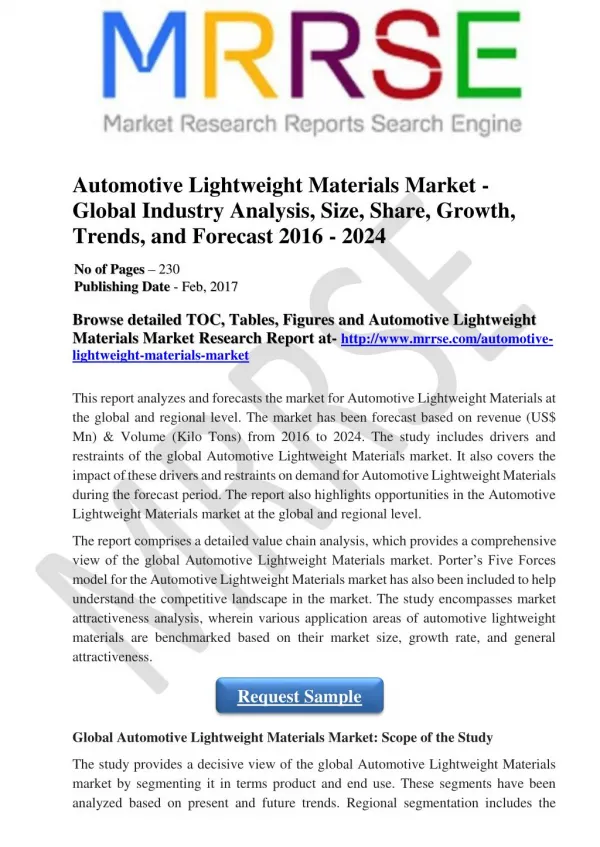Automotive Lightweight Materials Market - Global Industry Analysis, Forecast 2016 - 2023
Low carbon dioxide emission is driving the demand for lightweight materials in the automotive industry. Various government regulations have forced original equipment manufacturers (OEMs) to significantly reduce carbon dioxide emissions in the near future. Premium OEMs have amplified the utilization of lightweight materials, especially carbon fiber in their vehicles. For instance, aluminum is used in the manufacture of transmission casings, wheels, and engine blocks. Furthermore, certain OEMs have commenced the use of aluminum for the entire vehicle. However, higher cost associated with designing of vehicle is expected to hamper market growth. Magnesium is another metal that is used in the automotive industry. It is less dense than steel and aluminum and is used in cross car beams and instrument panels. Composites, another lightweight material, are one of the fastest growing product segments in the automotive industry. However, use of composites is limited to designer components. They have restrained use in structural parts of vehicles. Glass fiber reinforced composite is primarily used in the automotive industry. However, carbon fiber-based composites are likely to grab a higher market share in the automotive lightweight materials market in the next few years. Carbon fiber-based composites are light in weight as compared to other lightweight materials. However, higher cost associated with carbon fiber-based composites is likely to hamper market growth in the near future. Browse Report With Full TOC : http://www.transparencymarketresearch.com/automotive-lightweight-materials-market.html Currently, lightweight materials are used widely in the aerospace industry. However, the automotive industry is expanding at a rapid rate and is expected to gain a higher market share in the lightweight materials market. Materials such as plastics, metals, and composites are used in the manufacture of automotive components. These lightweight materials can be used to manufacture structural parts, interiors, and exteriors of the vehicle. High-strength steel, plastic, carbon fiber, glass fiber, and aluminum are some of the lightweight materials employed in the automotive industry. These materials possess higher strength and are lighter in weight Lightweight materials have a positive impact on the fuel economy. Lighter the weight of the vehicle, lesser would be the fuel consumption. If the mass of a vehicle is reduced by 10%, the fuel consumed by the vehicle would be lowered by 4% to 6%, as it takes less effort to accelerate and move the vehicle. Lightweight materials also enhance the performance of the vehicle, bettering parameters such as handling and acceleration. Furthermore, automakers would obtain more freedom due to the introduction of lightweight materials in the automotive industry. Lightweight materials enable designers to come up with battery-operated vehicles that are available at a lower cost and offer high performance. Enquiry Before Buying : http://www.transparencymarketresearch.com/sample/sample.php?flag=B&rep_id=8509
★
★
★
★
★
171 views • 5 slides

